(Teksti suomeksi löytyy blogin lopusta)
I feel a little nervous. I stop the car and decide to walk the rest of the way. In the boreal coniferous forest there’s a new-looking forest road that seems to turn to the right direction. Nevertheless, approaching the site by any other means than on foot would feel wrong. Very disrespectful.
I am in Eastern Lapland and visiting a sieidi, a former sacred place of the Forest Lapp people.
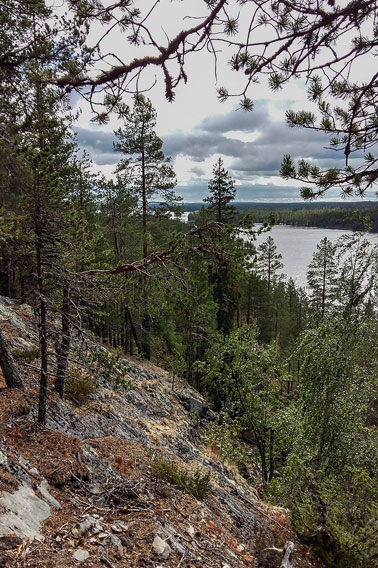
I visited the place for the first time as a child, when I was still a little girl, tyttärenmärri, as I’d say in my dialect.
It was Midsummer’s Eve, and my parents had heard that there was a dance many villagers were going to attend. They took me along, and I still remember the long walk and the steep ascent at the end of the trail which led us to a flat cliff top.
Between the stunted treetops, a magnificent panorama with vast open waterways unfolded in front of us.
Later in life, I often thought about this distinctive hilltop that was visible in the distant landscape. I had not connected it with the Forest Lapp culture until I came across a map at an exhibition at Siida, the Sámi Museum in Inari. The map demarcated the territory which the Lapps considered their own in the 17th century. This special hilltop in my homeland was visibly marked on the map and carefully contained within the Lappish administration area.
Now, on my way up to sieidi, I pass a sparse commercial pine forest, a sphagnum bog with a rich scent of peat moss, and a new logging area, as the slope leading to the sacred hilltop gradually becomes steeper. The new forest road has been pushed as close to the top of the cliff as possible, and as if that were not enough, there’s even a small parking lot! I study the rugged tracks the road construction machines have left behind and the distance of the road from the hilltop. Is somebody planning to turn this place into a tourist attraction?
According to the official definition, sieidis represent an integral part of the Sámi culture as sacred places of worship and offering. Sieidis exist also in central and southern Lapland, far from the current homeland of the Sámi people. Only a few centuries ago the area known as Kemi Lapland comprised the Lappish villages of Kittilä, Sodankylä, Inari, Kuolajärvi, Sompio, Keminkylä, Kitka and Maanselkä. The region was inhabited by the Forest Lapps, who have also been referred to as the Forest Sámi1.
Tiina Äikäs from the University of Oulu has studied the sacred places located in Finnish Lapland2. According to Äikäs, the holy places have been part of the so-called “taskscape”, which denotes a significant landscape not only for ritual activities but for livelihood as well.
Now that I think of my home area and all its places of worship (or places that bear all the hallmarks of a holy place), they seem to have one thing in common: most of them have particularly great views of fish-abundant waters. In the lives of Forest Lapps, holiness and everyday life were closely intertwined, or as Äikäs states, “People lived in a sacred landscape and their connection to the afterlife was interactive and manifested in many forms that were not limited to the liminal [border] places of the landscape”.
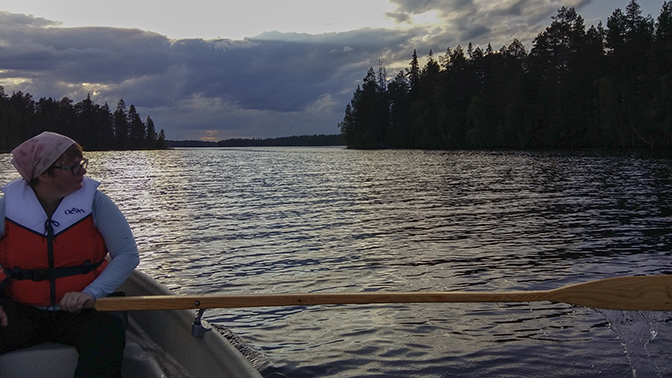
A serene moment at dusk in Forest Lapland.
As with this place, there are several similar sites in my home area where, according to tradition, dances were organised in the old days. This makes me wonder: Could it be that after Christianity had gained foothold in Forest Lapland the sacred places in the area became sites for social gathering and dancing for the villagers nearby? Ethnographer Samuli Paulaharju had made similar observations in Sompio in the 1940s, where the former places of sacrifice of Forest Lapps now served as “playgrounds for summer frolics and noisy merry-making”3.
As I climb atop the cliff, I admire the view as well as the steeply declining slope towards the familiar fishing waters of our family. They say that nowadays gillnet fishing for household consumption has become much rarer and something merely old folks still do, as it has largely been replaced by recreational lure fishing. Likewise, the dances for the villagers have probably become a thing of the past. If the scenarios4 for the growth of the number of tourists in Lapland come true in the future, it may impact the future use and significance of this site, too.
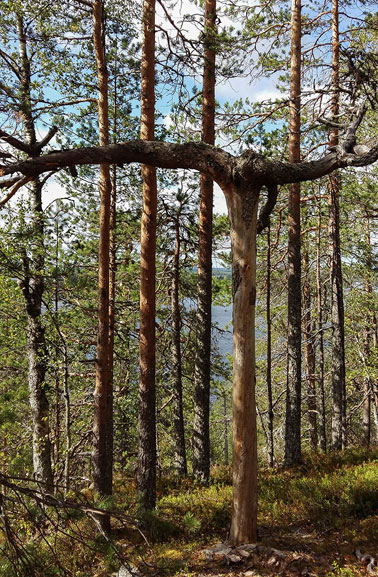
According to Tiina Äikäs, the life cycle of a sacred place can also include the re-use of a place, as the identity of a place is not permanent but constantly redetermined through the activities that take place there.
Äikäs also points out that when it comes to the protection of holy places, it has been considered important to ensure the local communities and residents the right to use the places and make decisions concerning them.
Distant view from the hill top.
Would it be possible to gather traditional information about these old “dance venues” in Forest Lapland and stories related to them? Would we then find more ancient sites of gathering and worship of Forest Lapps? At the same time, it might launch a much-needed discussion on the use of places with rich cultural heritage and the role of ethical and culturally responsible tourism in Lapland.
Growing up in the Forest Lapp culture, I am delighted to come across the works of a contemporary visual artist, who in his art addresses the key themes of our culture, including nature and the changing seasons.
Teuvo Tuomivaara‘s sculptures reflect the wonder the artist experiences at the growth and cycle of nature, which as such represent a defining characteristic of his work. He distances and reduces the idea, story, or myth he has received from nature, and it often brings along a statement for nature. He uses for example wood, bronze and steel as his material.
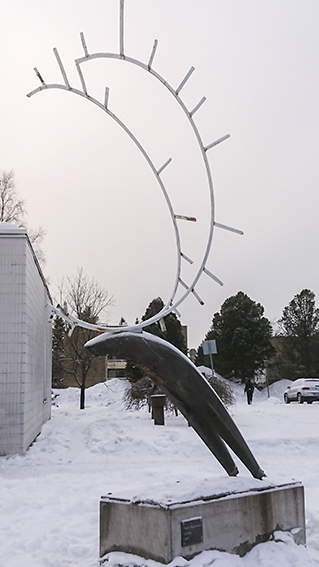
Critic Marjaana Niskala5 finds a lot of mythical ingredients in Tuomivaara’s work in the late 1990s and also memories of the old fishing culture, such as shapes of trap structures or niliaitta, a traditional type of storage hut. According to Niskala, Tuomivaara’s “sieidiness of tall sculptures connects them to old beliefs”.
To me, when I study Tuomivaara’s sculptures, they seem to ‘grow’ out of Lapland’s soil. As a viewer, I sense that his works are strongly rooted in place, time and landscape.
‘Loikka‘ (2007) by Teuvo Tuomivaara.
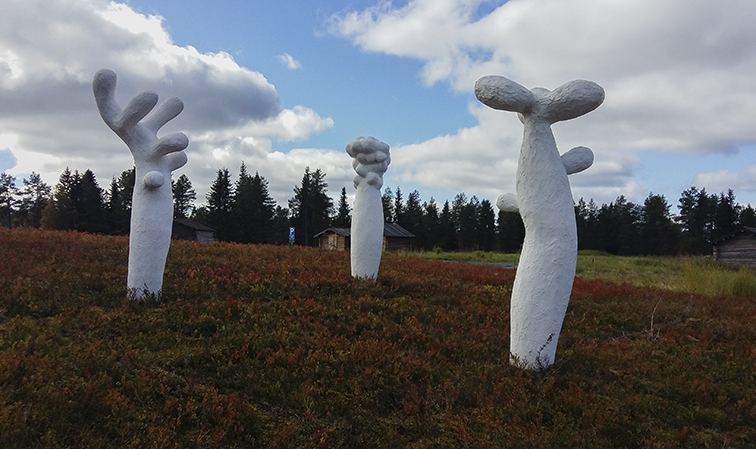
‘Hirvaan hurmio‘ (2018) by Teuvo Tuomivaara.
Sources:
1 The Forest Lapp Culture and its Advancement. Publications of the Government´s analysis, assessment and research activities 2019:43. http://urn.fi/URN:ISBN:978-952-287-763-5
2 Äikäs Tiina, 2011. From Boulders to Fells. Sacred Places in the Sámi Ritual Landscape. Monographs of the Archaeological Society of Finland 5.
3 Paulaharju Samuli. Cited by Äikäs 2011.
4 Tarssanen Sanna: The rush of Chinese tourists and other myths – Facts about Lapland tourism (in Finnish). Retrieved at https://www.lapland.fi/fi/business/nousukayralla-blogi/, 1 March 2022.
5 Niskala Marjaana, 2000: Sculptures by Teuvo Tuomivaara. Exhibition catalog of the exhibition held at Aine Art Museum 3.11.-31.12.2000.
Text ©Kaisa Kerätär
Photos by Kaisa Kerätär.
Translation by NorthLing.
Metsälappalainen tehtävämaisemassa
Jännittää. Pysäytän auton, ja päätän edetä loppumatkan kävellen. Tuoreen näköinen metsäautotie näyttäisi kääntyvän mäntykankaalta oikeaan suuntaan, mutta lähestyminen muulla keinoin kuin jalkapatikassa tuntuisi väärältä. Hyvin epäkunnioittavalta.
Olen Itä-Lapissa, ja käymässä metsälappalaisten vanhalla pyhällä paikalla, seidalla.
Kävin paikalla ensi kertaa lapsena, pikku tyttärenmärrinä. Oli juhannusaatto, ja vanhemmat olivat kuulleet siellä järjestettävistä tansseista. Pääsin mukaan, ja muistan yhä pitkän kävelymatkan, lopussa raskaan ylämäen sekä tasaisen kalliohuipun, josta maisema avautui käkkyräisten männynlatvojen välistä suurille järvenselille useaan ilmansuuntaan.
Kaukomaisemassa hyvin erottuva vaarannokka mietitytti usein myöhemmin, enkä tullut liittäneeksi sitä metsälappalaiseen kulttuuriin. Kunnes löysin saamelaismuseo Siidan näyttelystä kartan. Siihen lappalaiset olivat itse merkinneet oman alueensa rajalinjan 1600-luvulla. Tuo kotiseutuni erikoinen maisemakohde erottui hyvin, ja kartalla se oli koukattu hyvin tarkasti lappalaisten hallinta-alueen sisäpuolelle.
Seidalle kävellessä ohitan niukkalajista talousmetsää, rahkasammalelta tuoksuvan suolämpäreen ja tuoreen hakkuuaukean, samalla kun vaaranrinne muuttuu vähitellen jyrkemmäksi. Vasta rakennettu metsäautotie näkyy jyrätyn niin lähelle kallionhuippua kuin suinkin on mahdollista, ja kaiken kukkuraksi on tehty myös pieni parkkipaikka! Tutkin konetyön rujoa jälkeä ja etäisyyttä seidalle. Meinataanko paikasta tehdä turistikohde?
Seidat ovat virallisen määritelmän mukaan saamelaiskulttuuriin liittyviä pyhiä palvontapaikkoja. Seitoja esiintyy myös Keski- ja Etelä-Lapissa, kaukana saamelaisten nykyiseltä kotiseutualueelta. Vielä muutamia satoja vuosia sitten tätä Kemin Lappina tunnettua aluetta, joka kattoi Kittilän, Sodankylän, Inarin, Kuolajärven, Sompion, Keminkylän, Kitkan ja Maanselän lapinkylät, asuttivat metsälappalaiset1, joista aiemmin on käytetty myös nimitystä metsäsaamelaiset.
Suomen Lapin alueella sijaitsevia seitoja on tutkinut Tiina Äikäs Oulun yliopistosta2. Äikään mukaan pyhät paikat ovat olleet osa ns. tehtävämaisemaa, maisemaa, joka on ollut tärkeää rituaalitoiminnan lisäksi myös toimeentulon kannalta.
Kotiseudullani sijaitsevista palvontapaikoista, tai pyhän paikan tuntomerkit hyvin täyttävistä kohteista tulee mieleen, että useimmilta on erityisen hyvät näkymät kalavesille. Metsälappalaisessa elämässä pyhyys ja arki olivat kietoutuneet tiiviisti toisiinsa tai kuten Äikäs toteaa ’Ihmiset asuivat pyhässä maisemassa ja heidän yhteytensä tuonpuoleiseen oli vuorovaikutteista ja ilmeni monissa muodoissa, jotka eivät rajoittuneet maiseman liminaalisiin [raja-] paikkoihin.’
Kuten tähänkin paikkaan, useaan vastaavaan kohteeseen kotiseudullani liittyy perimätieto myös tanssien järjestämisestä vanhaan aikaan. Olisiko mahdollista, että kristinuskon vakiinnutettua asemansa Kemin Lapissa, alueen palvontapaikkojen käyttötarkoitus olisi muuttunut lähikylien yhteisiksi kokoontumis- ja tanssipaikoiksi? Myös kansantieteilijä Samuli Paulaharju oli törmännyt Sodankylässä tietoon, jossa entinen lappalaisten uhripaikka toimi ’kesäisenä kisapaikkana, remuisana ilopaikkana3.
Nousen kalliohuipulle ihastelemaan näkymää sekä jyrkästi putoavaa rinnettä alapuolella oleville, perheemme tutuille kalavesille. Sanovat, että verkkokalastus kotitarpeiksi on vähentynyt ja ukkoutunut, vaihtunut viehepyyntiin. Eikä paikalla liene järjestetty kyläläisten tanssejakaan enää. Mikäli skenaariot4 turistien määrän kasvusta Lapissa toteutuvat tulevaisuudessa, voi se tietää muutosta tämänkin kohteen tulevassa käytössä ja merkityksessä.
Tiina Äikään mukaan seidan elinkaareen voi liittyä myös paikan uudelleenkäyttö, sillä paikan identiteetti ei ole pysyvä, vaan se määräytyy koko ajan uudestaan siellä tapahtuvan toiminnan kautta. Äikäs myös muistuttaa, että pyhiä paikkoja suojeltaessa on pidetty tärkeänä taata paikallisille yhteisöille ja asukkaille oikeus paikan käyttöön ja päätöksentekoon.
Olisikohan Metsä-Lapissa mahdollista koota perimätietoa näistä vanhoista ’tanssipaikoista’ ja niihin liittyvistä tarinoista? Löytyisikö siten mahdollisesti lisää metsälappalaisten muinaisia kokoontumis- ja palvontapaikkoja? Samalla voisi myös käynnistää keskustelua merkityksellisten paikkojen eettisesti ja kulttuurisesti vastuullisesta matkailukäytöstä Lapissa.
Metsälappalaiseen kulttuuriin kasvaneena ilahdun törmätessäni nykytaiteilijan tuotantoon, jossa kulttuurimme keskeisiä teemoja, luontoa ja vuodenaikoja voi löytää taideteoksissa.
Teuvo Tuomivaaran veistoksissa heijastuu taiteilijalle tyypillinen luonnon kasvun ja kierron ihmettely. Luonnosta saamansa idean, tarinan tai myytin hän etäännyttää ja pelkistää, ja usein tuo mukaan kannanoton luonnon puolesta. Teosten materiaaleja ovat mm. puu, pronssi ja teräs.
Kriitikko Marjaana Niskala5 löytää Tuomivaaran 1990-luvun lopun tuotannosta paljon myös myyttisiä aineksia sekä muistumia vanhasta pyyntikulttuurista, ansarakennelmien tai niliaitan portaiden muotoja. Niskalan mukaan Tuomivaaran ’korkeiden veistosten seitamaisuus liittää ne vanhoihin uskomuksiin’.
Itse koen, että Tuomivaaran veistokset ikään kuin ’kasvavat’ lappilaisesta maaperästä. Katsojana aistin teoksilla olevan vahvat juuret paikkaan, aikaan sekä maisemaan.




